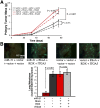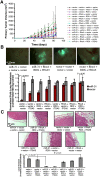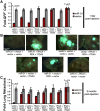Concomitant suppression of three target genes can explain the impact of a microRNA on metastasis
- PMID: 19875476
- PMCID: PMC2779763
- DOI: 10.1101/gad.1832709
Concomitant suppression of three target genes can explain the impact of a microRNA on metastasis
Retraction in
-
Retraction: Concomitant suppression of three target genes can explain the impact of a microRNA on metastasis.Genes Dev. 2015 Mar 15;29(6):686. Genes Dev. 2015. PMID: 25792602 Free PMC article. No abstract available.
Abstract
It remains unclear whether a microRNA (miRNA) affects a given phenotype via concomitant down-regulation of its entire repertoire of targets or instead by suppression of only a modest subset of effectors. We demonstrate that inhibition of breast cancer metastasis by miR-31-a miRNA predicted to modulate >200 mRNAs-can be entirely explained by miR-31's pleiotropic regulation of three targets. Thus, concurrent re-expression of integrin-alpha5, radixin, and RhoA abrogates miR-31-imposed metastasis suppression. These effectors influence distinct steps of the metastatic process. Our findings have implications concerning the importance of pleiotropy for the biological actions of miRNAs and provide mechanistic insights into metastasis.
Figures




References
Publication types
MeSH terms
Substances
Grants and funding
LinkOut - more resources
Full Text Sources
Other Literature Sources
Medical
